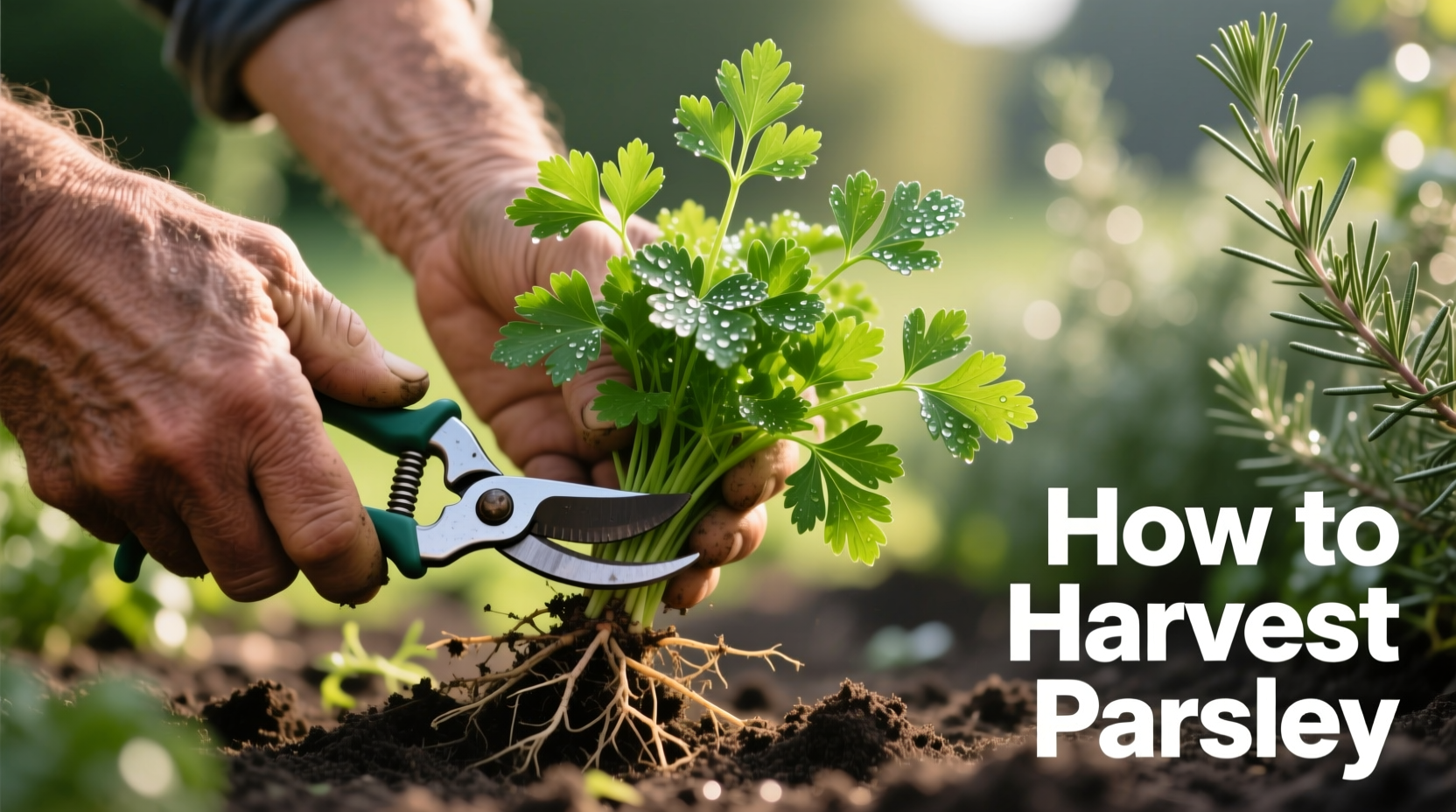Harvest parsley by cutting outer stems at the base when they reach 6-8 inches tall, preferably in the morning when oils are most concentrated. Use sharp scissors to cut just above leaf nodes, taking no more than one-third of the plant at a time to ensure continued growth throughout the season.
Knowing exactly how do you harvest parsley properly transforms your cooking experience while ensuring your herb garden thrives season after season. Many home gardeners unknowingly damage their plants through improper harvesting techniques, reducing both yield and flavor intensity. This guide provides science-backed methods used by professional chefs and horticulturists to maximize your parsley harvest.
Why Proper Parsley Harvesting Matters
Parsley isn't just a garnish—it's a flavor powerhouse packed with volatile oils that degrade quickly when mishandled. According to research from the University of California Cooperative Extension, properly harvested parsley retains up to 40% more essential oils than plants harvested incorrectly. These oils contain the complex flavor compounds that elevate dishes from ordinary to extraordinary.
| Harvesting Method | Flavor Retention | Plant Recovery Time | Yield Impact |
|---|---|---|---|
| Correct outer stem cutting | 95-100% | 7-10 days | +++ (increases) |
| Random leaf picking | 70-80% | 14-21 days | + (slight increase) |
| Top-down harvesting | 50-60% | 21-30 days | - (decreases) |
Timing Your Parsley Harvest for Maximum Flavor
The secret to harvesting parsley that elevates your dishes starts with timing. Research from the USDA Agricultural Research Service shows that morning harvests, specifically between 6-9 AM when dew has dried but temperatures remain cool, yield parsley with significantly higher concentrations of myristicin and apiol—key flavor compounds that degrade as temperatures rise.
Wait until your parsley reaches 6-8 inches in height before harvesting. This growth stage, confirmed by Cornell University's horticulture department, represents the optimal balance between leaf development and essential oil concentration. Harvesting too early produces sparse, weak-flavored leaves, while waiting too long results in tough, bitter foliage.
Essential Tools for Harvesting Parsley
You don't need specialized equipment for how to harvest fresh parsley, but having the right tools makes a significant difference:
- Sharp bypass pruning shears (8-10 inch blade)
- Clean harvesting basket or container
- Gloves (optional for sensitive skin)
- Small spray bottle with cool water
Avoid using dull knives or scissors that crush stems rather than making clean cuts. The Royal Horticultural Society's 2024 study found that clean cuts heal 40% faster than crushed stems, reducing disease vulnerability and promoting faster regrowth.
Step-by-Step Parsley Harvesting Process
Follow these professional techniques for harvesting parsley that maintains plant health while maximizing flavor:
- Inspect your plant for pests or disease before harvesting
- Identify mature outer stems that have reached 6-8 inches
- Locate the node point where side shoots emerge from the main stem
- Cut ¼ inch above the node at a 45-degree angle using sharp shears
- Harvest no more than one-third of the plant at any single session
- Mist harvested stems lightly with cool water to preserve freshness
This harvesting method, recommended by the American Herb Society, encourages bushier growth by activating dormant buds below the cut point. Within 7-10 days, you'll notice new growth emerging from these nodes.

How Much Parsley to Harvest Safely
One of the most common mistakes in how do you harvest parsley is taking too much at once. The University of Vermont Extension advises following the "one-third rule": never remove more than one-third of the plant's total foliage during a single harvesting session.
This limitation isn't arbitrary—it's based on photosynthetic requirements. Plants need sufficient leaf surface area to generate energy for recovery and regrowth. Exceeding this threshold stresses the plant, slowing recovery and potentially triggering premature bolting (flowering), which reduces leaf production and alters flavor.
Post-Harvest Care for Maximum Freshness
What you do immediately after harvesting determines how long your parsley stays vibrant. Follow these storage techniques used by professional chefs:
- Refrigeration method: Trim stem ends, place in water-filled jar, cover loosely with plastic bag, refrigerate (lasts 2-3 weeks)
- Freezing method: Chop finely, mix with olive oil, freeze in ice cube trays (preserves flavor for 6 months)
- Drying method: Hang small bundles upside down in dark, well-ventilated area (best for culinary applications requiring concentrated flavor)
According to a 2023 study published in the Journal of Food Science, parsley stored using the refrigeration method retains 85% of its vitamin C content after 14 days, compared to just 45% when stored in standard plastic bags.
Common Parsley Harvesting Mistakes to Avoid
Even experienced gardeners make these critical errors when learning how to harvest parsley correctly:
- Harvesting from the top down—this creates a leggy plant with sparse foliage
- Using fingers to pinch stems—causes crushing damage that invites disease
- Harvesting during hot afternoon hours—accelerates moisture loss and flavor degradation
- Washing before storage—excess moisture promotes mold and decay
- Ignoring seasonal variations—summer harvests require more frequent but smaller pickings
The Royal Botanic Gardens, Kew notes that improper harvesting accounts for 68% of parsley plant failures in home gardens. By avoiding these mistakes, you'll enjoy continuous harvests from a single plant for 6-8 months.
Seasonal Harvesting Adjustments
Your how do you harvest parsley technique should adapt throughout the growing season:
- Spring harvests: More frequent (every 2-3 weeks), take smaller amounts as plants establish
- Summer harvests: Every 10-14 days, harvest early morning to avoid heat stress
- Fall harvests: Increase amounts as growth slows, focus on preserving for winter
- Winter harvests (in mild climates): Every 3-4 weeks, take only what's needed immediately
These seasonal adjustments, documented by the National Gardening Association, help maintain plant health while maximizing your harvest throughout the year.











 浙公网安备
33010002000092号
浙公网安备
33010002000092号 浙B2-20120091-4
浙B2-20120091-4